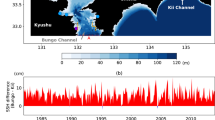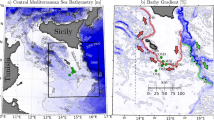Abstract
The Tsugaru Strait, which connects the Sea of Japan with the Pacific Ocean, is characterized by the eastward Tsugaru Warm Current (TWC) and oscillating tidal currents of similar magnitude. A 15-day current observation was conducted in one of the two narrow channels in the strait, at the northwest tip of the Shimokita Peninsula. The observation revealed that the spectral energy of the semidiurnal current exceeds that of the diurnal current, contrary to the conventional view. The Tsugaru Strait regional model was developed to study the mechanism of this spectral energy reversal (140–141.5° E, 40.4–42.6° N, 500 m grid resolution). At the eastern and western open boundaries, the model was driven by the constant Tsugaru warm current and tidal elevation, which was adjusted by comparing the model with tidal gauge observations within the channel. The relative magnitude of the spectral energies differed from that of the observation when the model was driven by tide only. However, the spectral energy levels were reversed when the model was driven by both tide and current. The nonlinear interaction of periodic tidal currents and the steady TWC was explained by the vorticity equation, which describes the production and advection of residual currents from tidal currents. According to the model results, flow separation and advection of vorticity by the TWC was the most prominent factor in this phenomenon. Because of the strong nonlinearities, flow separation around the headland occurred during the tidal period with dominant current magnitude and furnished the main difference between the diurnal and semidiurnal interactions. These phenomena were enhanced by the complex topography, and demonstrate the importance of scale interaction, especially when developing high-resolution regional models.

















Similar content being viewed by others
References
Banas NS, Hickey BM (2005) Mapping exchange and residence time in a model of Willipa Bay, Washington, a branching, macrotidal estuary. J Geophys Res 110:C11011. doi:10.1029/2005JC002950
Cheng RT, Casulli V, Gartner JW (1993) Tidal, residual, intertidal mudflat (TRIM) model and its applications to San Francisco Bay, California. Estuar Coast Shelf Sci 36:235–280
Guo X, Hukuda H, Miyazawa Y, Yamagata T (2003) A triply nested ocean model—roles of horizontal resolution on JEBAR. J Phys Oceanogr 33:146–169
Isoda Y, Baba K (1998) Tides and tidal currents in the Tsugaru Strait. Bull Fish Sci Hokkaido Univ 49(3):117–130
Japan Marine Safety Agency (1992) Tidal harmonic constants tables. Japanese coast, Japan Hydrographic Association, Tokyo, p 267
Japan Meteorological Agency (2004) Kisho Toukei Jouhou. Available from: http://www.jma.go.jp/jma/indexe.html. Accessed August 2011
Katsumata K (2005) Two- and three-dimensional numerical models of internal tide generation at a continental slope. Ocean Model 12(1–2):32–45
Le Provost C, Fornerino M (1985) Tidal spectroscopy of the English Channel with a numerical model. J Phys Oceanogr 15:1009–1031
Maddock L, Pingree RD (1978) Numerical simulation of the Portland tidal eddies. Estuar Coast Mar Sci 6:353–363
Matsumoto K, Takanezawa T, Ooe M (2000) Ocean tide models developed by assimilating TOPEX/POSEIDON altimeter data into a hydrodynamical model: a global model and a regional model around Japan. J Oceanogr 56:567–581
Miyazawa Y, Guo X, Yamagata T (2004) Roles of mesoscale eddies in the Kuroshio path. J Phys Oceanogr 34:2203–2222
Miyazawa Y, Yamane S, Guo X, Yamagata T (2005) Ensemble forecast of the Kuroshio meandering. J Geophys Res 110:C10026, 14
Nishida Y (2003) Seasonal and interannual variations of the volume transport through the Tsugaru Strait. Oceanogr Jpn 12(5):487–499 (in Japanese)
Odamaki M (1984) Tide and tidal current in Tsugaru Strait. Bull Coast Oceanogr 22:12–22, in Japanese
Ogura S (1932) The tide of Tsugaru Strait. Hydrogr Bull 110:1–26, in Japanese
Ogura S (1933) The tides in the seas adjacent to Japan. Rep Hydrogr Res 7:1–189
Onishi M, Isoda Y, Kuroda H, Iwahashi M, Satoh C, Nakayama T, Ito T, Iseda K, Nishizawa K, Shima S, Togawa O (2004) Winter transport and tidal current in the Tsugaru Strait. Bull Fish Sci Hokkaido Univ 55(2):105–119
Oonishi Y (1977) A numerical study on the tidal residual flow. J Oceanogr Soc Jpn 33:207–218
Pingree RD, Maddock L (1977) Tidal residuals in the English Channel. J Mar Biol Assoc U K 57:339–354
Saitou T, Sakamoto M, Kasai M, Nanjo H (2006) Measuring the current velocity around Bentenjima in the Shimokita Penisula. Bull Fac Sci Technol Hirosaki Univ 8:37–66
Schiller A (2004) Effects of explicit tidal forcing in an OGCM on the water-mass structure and circulation in the Indonesian throughflow region. Ocean Model 6:31–49
Yanagi T (1976) Fundamental study on the tidal residual circulation 1. J Oceanogr Soc Jpn 32:199–208
Acknowledgement
We express our gratitude to the members of Hirosaki University who measured the current velocity and kindly provided us with the data.
Author information
Authors and Affiliations
Corresponding author
Additional information
Responsible Editor: Leo Oey
The English in this document has been checked by at least two professional editors, both native speakers of English. For a certificate, please see http://www.textcheck.com/certificate/PYf1aX.
This article is part of the Topical Collection on the 3rd International Workshop on Modelling the Ocean 2011
Rights and permissions
About this article
Cite this article
Wada, R., Waseda, T. & Nanjo, H. Nonlinear interaction of the Tsugaru Warm Current and tide in the Tsugaru Strait. Ocean Dynamics 62, 923–941 (2012). https://doi.org/10.1007/s10236-012-0535-7
Received:
Accepted:
Published:
Issue Date:
DOI: https://doi.org/10.1007/s10236-012-0535-7




